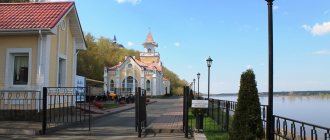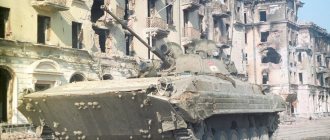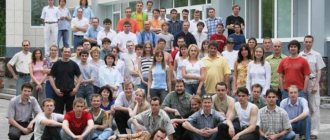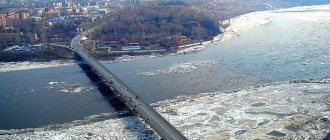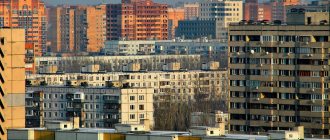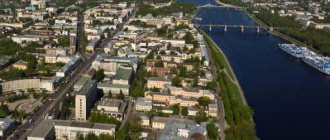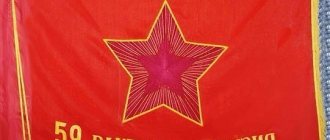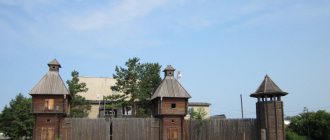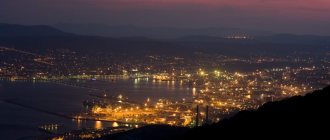General information and history of Sarapul
Sarapul is one of the oldest cities in the Kama region, a city located in the southeastern part of the Udmurt Republic, on the right bank of the Kama River.
The distance to Izhevsk is 62 km, to Moscow – 1250 km. A village called Sarapul appeared in 1707, and city status was received in 1780. A fairly favorable geopolitical and geographical location helped Sarapul gain the unofficial status of one of the most successful cities in the Kama region.
Sarapul. View of the city center from the Kama River
Sarapul is home to a large number of architectural monuments. Previously, the city had 33 churches and 2 monasteries. Currently, the Church of the Ascension, Intercession and Xenia of St. Petersburg have been preserved.
Ascension Church
Today Sarapul is a major industrial center of the Udmurt Republic. The joint-stock enterprises radio and electric generating plant are the industrial face of the city.
The most interesting museums
In Sarapul there are many interesting museums dedicated to the history of the formation of the republic and its traditions.
Museum of History and Culture of the Middle Kama Region
The museum is located at: Sarapul, st. Pervomaiskaya, house No. 68. It is located in a building built in 1909, which is an architectural monument of republican significance.
The museum exhibition has 3 parts:
- art exhibition;
- things that belonged to Academician Melnikov;
- historical local history exhibition.
There are more than 20 thematic collections of 200 thousand exhibits here.
Sarapul. The attractions include the Museum of History and Culture of the Middle Kama Region.
The most valuable exhibits:
- ancient Egyptian ushabti figurines, which were placed in the grave along with the dead;
- ancient early printed Gospel of 1595;
- banner of Napoleon's Guard;
- newsreel of Sarapul 1912;
- The daggerotypes of the mid-19th century are the world's first photographs made using the photosensitivity of silver iodide.
Sarapul Radio Plant Museum
The Museum of Radio Engineering is located: Sarapul, st. Gogol, house No. 40. The museum at the radio plant contains military and civilian exhibits produced since 1977.
Displayed here:
- anniversary 10 millionth radiogram “Ural”;
- the Comet radio, which won the World Radio Engineering Exhibition in Brussels in 1958;
- military radio stations of the Soviet period;
- radio equipment that was used when landing aircraft in poor visibility.
Almost all of the museum's exhibits are in working condition.
House-Museum of Academician Nikolai Melnikov
The memorial house-museum is located at the address: Sarapul, st. Efima Kolchina, house No. 37. Here lived the family of a great Soviet and Russian scientist who devoted his life to the study of mining and mineral extraction.
On the ground floor of the building, the atmosphere reflecting the beginning of the 20th century has been recreated. On the second floor of the building, objects from the academician’s life and his scientific works are collected.
Climate and ecology of Sarapul
Sarapul is located in a zone of temperate continental climate (consistently hot summers, consistently cold winters and low precipitation). The average annual temperature is +3.4 °C (in summer the thermometer can rise to +36 °C, and in winter it can reach -34 °C). The average annual wind speed is 3.1 m/s, and air humidity reaches 69.7%.
Winter in Sarapul
The ecological state of the city cannot be called terrible, but it does not qualify for an “excellent” rating. The main sources of air pollution include public utilities, metalworking and machine-building enterprises, as well as enterprises specializing in the food industry.
As for reservoirs, the most polluted rivers are the Kama and Bolshaya Sarapulka. They are negatively affected by such enterprises as the Sarapul Machine-Building Plant, a poultry factory, a meat processing plant and a radio plant. Sources of pollution also include household waste dumps growing in the south and west of Sarapul.
Population of the city of Sarapul
At the beginning of 2014, 99,869 people lived in Sarapul. The city is multinational: 82% of the population are Russians, 9.2% are Tatars, 3.8% are Udmurts, and the remaining 5% of the population accounts for more than sixty nationalities.
Day of the city
It is worth noting that the mortality rate in Sarapul (as well as in the Udmurt Republic as a whole) exceeds the birth rate. There are often cases when residents leave the city, moving to larger settlements, which, together with the previous factor, leads to a decrease in the city’s population.
The level of education and morality in the city is high, because there are many different educational institutions in Sarapul. In addition, in 2010, the Public Council of the Municipal Municipality “City of Sarapul” was organized, which included representatives of 20 associations and public organizations of the city. At the same time, the total number of public organizations reaches 40 (trade unions, religious, national-cultural, veterans, etc.).
Museum "Bashenina's Dacha"
This snow-white museum and exhibition complex, which is located along Dostoevsky Street
60, considered to be the hallmark of the city of Sarapul, has always attracted the attention of tourists. An architectural masterpiece located among wild trees
A special feature of the palace was its unique appearance, which creates some visual illusion. At first inspection, it may seem that the palace is made of log beams. In fact, during construction, stone was used, which easily imitates a wooden surface in its appearance.
The estate was the property of the family of the merchant Bashenin until 1917. As a result of the revolutionary coup, the palace became state property. In 1995, the estate was transferred to the city museum and became a landmark of Sarapul. The rooms of the palace include the following exhibitions: a living room, outbuildings, as well as a winter garden and other rooms that convey the atmosphere of merchant life of the last century.
Districts and real estate of Sarapul
Sarapul is a provincial town, officially divided into 8 districts, including Center, Startseva Gora, Privokzalny, Novoselsky, Yuzhny, Gudok, Yamy and Simonikha.
Sarapul Map
Now we will consider each district of the city of Sarapul separately, paying attention to residential buildings and the estimated cost of apartments.
The center is the heart of the city. There are administration buildings, museums, a church and many retail outlets here. The central region borders the Kama River, so there are plenty of picturesque places here. Unfortunately, in the very center of the city there are many buildings built more than a century ago that are in need of reconstruction. Restoration work is underway, but extremely slowly, so we can only hope that the center of this beautiful town will someday take on a more decent appearance.
There are not many residential buildings in the Central District; these are mainly private wooden houses, many of which are in need of repair.
Sarapul city administration building
Startseva Gora is a fairly quiet and peaceful area of the city, despite its proximity to the center of Sarapul. It is pleasant to walk along the streets of this area, because cleanliness and order reign here, and numerous trees complete the picture.
Startseva Gora is a very old area; it is not surprising that the only buildings here are wooden residential buildings. An excellent place for lovers of beautiful landscapes and fishing, since the Kama River is literally a stone's throw from here.
Startseva Mountain
The station area is located in the southwestern part of the city. It is not difficult to guess that the railway station is located here. Despite the distance from the city center, the Station area is full of life. Of course, the small town falls asleep at night, but during the day its streets are quite lively. Among the residential buildings there are 5-story and 4-story buildings, and the cost of a one-room apartment in the area exceeds 800 thousand rubles. It is worth adding that gardening plots have found their place on the outskirts of the Station District.
Novoselsky is a tiny area, more like a village. Forest, river, paths, garden plots, wooden houses... The Novoselsky district is a valuable area from an urban planning point of view, it is quite possible that in the future 4, 5 or even 9-story residential buildings will rise here.
Novoselsky District
The southern district is even more remote from the center of Sarapul, but a considerable part of the townspeople live here. The area is separated from the rest of the city by garage cooperatives, a railroad, and a forest. In the Southern district, 5- and 9-story residential buildings were erected, and construction continues today. The cinema center and the city market are also located here. A one-room apartment in this area will cost buyers 700-900 thousand rubles.
Southern region
Yamy is an urban area located east of the shoe factory. The area owes its name to the massive garage construction and vegetable pits located in garages. There are not many residential buildings here; most of them are one-story wooden or stone houses.
Yama area
The northernmost district of Sarapul is Gudok. Smooth streets, good roads, but not a single multi-story building. Private residential buildings are being built here, but the area’s somewhat remote location from the bank of the Kama River makes its land less valuable than, for example, plots located on Startsevaya Mountain.
House. Gudok District
On the left bank of the Kama there is a microdistrict of the city of Sarapul called Simonikha. Life used to be in full swing here, but the construction of the Nizhnekamsk hydroelectric power station led to the flooding of the village. Most of the local residents were resettled, and the post office, kindergartens, and schools were closed. In the summer, the passenger ferry of the Sarapul River Port OJSC operates here, and in the winter, residents of Simonikhi cross the river on ice.
From all over the world
And a century earlier, at the very end of the 19th century, everything in Sarapul rested on the “city fathers” - wealthy Sarapul merchants. By 1910 there were 179 of them in the city and 1,050 non-guild members - this is a lot. They were amazing, colorful people - they moved hundreds of thousands, lived luxuriously, built luxurious mansions, wiping the noses of their competitors, but they didn’t forget about the city. Thanks to their efforts, everything has been established and built in Sarapul: a water supply system, an electric station, a railway, a great many charitable and educational institutions.
The merchant Bodalevs “rose up” by trading in bread and producing intoxicating drinks. Kurbatov and Kolchin were engaged in shipbuilding. The country owes the famous creaking Sarapul boots to Poshekhonov, Smagin and Mikheev; in total, up to 2 million pairs were produced in the city on the Kama in 1912, every third boot of the Russian army in the First World War was made in Sarapul. The forest became a source of wealth for Koreshev and Bashenin.
To the latter, a merchant of the 1st guild and the mayor of the city, Sarapul owes a lot - a water supply system, a power plant. Finally, the future Museum of History and Culture of the Middle Kama Region, opened in 1909, is the oldest and, perhaps, the best local history museum in Udmurtia. Where else can you see a piece of an iron bridge pierced by a shrapnel, real Sarapul boots or an authentic banner of Napoleonic guards - there, and nowhere else.
Pavel Bashenin also gave Sarapul his unofficial symbol - a dacha named after him. Today it is also a museum, allowing you to plunge into the amazing atmosphere of rich merchant life: from a polished samovar on the table, impressive items in the buffet and a “hemp” pipe to paintings by great masters of their time. Alas, Pavel Andreevich himself, having built a dacha in 1909, passed away a year later, without having time to truly enjoy the fruits of his great labors.
But thanks to him, everyone has such an opportunity. The building of the first Sarapul water tower, Bashenin's House on Truda Street, the Museum of History and Culture of the Middle Kama Region and Bashenin's Dacha are must-see objects in Sarapul.
The merchants usually dined at home, around two in the afternoon. By this time, the team of the Uterra media group, having received a lot of impressions, was pretty hungry. It was decided to go to the KYOTO Cooking studio restaurant on Sovetskaya, 86.
The KYOTO Cooking studio restaurant justifies its status as a culinary studio Photo: Aif-Udmurtia
Once upon a time, the KYOTO studio was famous in Sarapul exclusively for Japanese cuisine - hence the name. But now it fully justifies the status of a culinary studio, having on its menu the best dishes not only of Japanese cuisine, but also of Pan-Asian, Uzbek, and, in the near future, cuisines of different nationalities. In other words, if you want culinary variety, come to KYOTO Cooking studio, which, however, has not forgotten about fans of traditional food - the establishment’s menu has a European and a separate fish page.
“We can accommodate up to 75 guests, and each of them will be able to choose a place to suit their taste - enjoy a leisurely meal, admire the panorama of the city, or, sitting on a cozy sofa, have a one-on-one meeting, or maybe hide from prying eyes in the longue zone,” says Irina Alieva, founder of the KYOTO culinary studio. — Or maybe you just want to sit with your laptop and have a cup of coffee? No problem, you have Italian coffee, signature tea and wi-fi at your disposal.”
However, real life at the KYOTO Cooking studio begins in the evening: you can relax to the sounds of a saxophone, piano and guitar, or take part in a show or culinary master class.
Summary
The team that created the KYOTO restaurant are true fans of their business, providing their guests with delicious and high-quality food and a pleasant atmosphere for a reasonable price, as the team of the Uterra media group, who was completely satisfied with the good lunch, was convinced of.
City infrastructure
The work of representatives of the housing and communal services complex can only be assessed as “satisfactory”, because even in the very center of the city there are many buildings that are in disrepair. However, repair and restoration work is being carried out, but not at all on the scale required. So, for 2008-2011 About 185 million rubles were allocated for major repairs of residential buildings. As a result, 176 apartment buildings were renovated, with a total area of 151 thousand square meters. m, and 18,037 people live in them. The supply of water, gas and electricity is carried out regularly, however, emergencies still arise from time to time, but the problems are resolved quickly enough.
One of the Sarapul courtyards
The cost of utilities cannot be called low: currently, owners of average one-room apartments pay about 2,000 rubles monthly. It is worth adding that this amount is getting higher every year, but this problem is also familiar to residents of other Russian cities.
In a relatively small city, traffic jams are out of the question. The problem of terrible road surfaces, so well known in Russia, has not spared Sarapul. Driving along some city streets is becoming more and more problematic over time. We can only hope that in the near future the city administration will pay more attention to this problem.
Quickly getting from one district of Sarapul to another will not be difficult, because there are more than 100 private taxis in the city, and 22 bus routes cover all city districts. There is also water transport in Sarapul. From May to October, two water routes “Sarapul-Barok” and “Sarapul-Ershovka-Simonikha” are opened for citizens.
You can get a good education in Sarapul without any problems. On the territory of the city there are 18 general education institutions, 3 correctional education institutions, 32 preschool education institutions and 7 additional education institutions.
Religious buildings
Sarapul has a huge number of iconic attractions that have special significance for the republic and the country as a whole.
Church of the Intercession of the Blessed Virgin Mary, Peter and Paul
The church is located at the address: Sarapul, st. Truda, house No. 38. The church is a single architectural complex, the oldest surviving in the city. The modern church building was erected in 1791 on the site of the old wooden one. In 1813, a stone bell tower and a temple named after the Holy Apostles Paul and Peter were added to the church.
The church has the largest bell in the city, its weight is 600 pounds. In 1932, the temple was converted into a bakery. Only at the end of the last century, the dilapidated church building was returned to the Orthodox Church and restoration began.
Temple of Blessed Xenia of St. Petersburg
Due to the lack of parishioners, the church was closed and transferred to the ownership of a military unit, which set up an armory in the building. And only in 1991 the church building was transferred to the Russian Orthodox Church.
The temple is located at the address: Sarapul, st. Gorky, house No. 74. The church building was built of red brick in the style of pseudo-Russian architecture. By the middle of the last century, the Old Believer community in the territory of Sarapul had practically disappeared.
Church of Seraphim of Sarov
This is a modern building, built from 2008 to 2013. It is located on the outskirts of Sarapul on Furmanov Street. The church is a structure made of logs and has a high bell tower.
Enterprises and work in Sarapul
The economic basis of the city is a large industrial complex, the main industries of which include mechanical engineering, food and light industry, production of building materials, plastic products, floriculture and printing.
Mechanical engineering is a leading industry, with the main specialization being the production of defense products, as well as products for civilian use. About 30% of the employed population of Sarapul works at the city’s machine-building enterprises. (At the beginning of 2012, there were 60,003 people of working age). The main enterprises in this industry are OJSC Sarapul Electric Generator.
Sarapul Electric Generating Plant
An important economic component of the city are food industry enterprises, whose products are supplied far beyond the borders of Sarapul and Udmurtia (bakery products, flour, dairy products, meat products, wine and vodka products). This industry is represented by the enterprises of ZAO Sarapulsky Beer, OJSC Sarapul Distillery and Vodka Plant, etc.
Light industry in Sarapul is represented by enterprises specializing in clothing and footwear production. The production of clothing is carried out by Sarapul Sewing Factory Mercury LLC, and the production of shoes is carried out by specialists from Shoe Factory Sarabella-Holding LLC.
Unfortunately, the average salary in the city can hardly be called decent. So, in 2009, residents of Sarapul received an average of 10,300 rubles.
Crime
Sarapul is a quiet and calm city, but even here the crime rate does not even think of reaching zero. It is not difficult to guess that many crimes are purely domestic in nature, and most of such acts occur as a result of excessive alcohol consumption. However, more high-profile crimes also happen in Sarapul. For example, drug trafficking cases regularly surface in the city. So, in 2011, a trio was convicted here for selling heroin to local drug addicts.
During 3 months of 2012, 404 crimes were committed in Sarapul. Statistics say that 80% of them are committed by non-working persons, while 40% of crimes are committed while intoxicated. It is worth adding that every second out of five criminal acts is committed by persons who have been prosecuted before.
An analysis of the operational situation shows that property theft is the most common type of crime in Sarapul.
The Sarapulsky Department of the Ministry of Internal Affairs of Russia is trying to maintain control over the crime situation, trying to reduce the number of crimes to a minimum. Let's hope that the quiet town of Sarapul will one day become absolutely safe.
